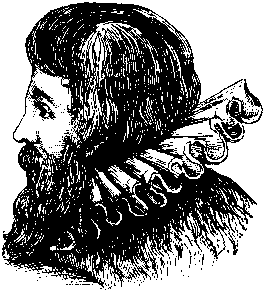Roger Ascham facts for kids
Quick facts for kids
Roger Ascham
|
|
|---|---|

Sketch of Roger Ascham
|
|
| Born | c. 1515 Kirby Wiske, Yorkshire, England
|
| Died | 30 December 1568 (aged 52-53) London, England
|
| Alma mater | St John's College, Cambridge |
| Occupation | Scholar, didactic writer |
|
Notable work
|
The Scholemaster |
Roger Ascham (born around 1515, died December 30, 1568) was an English scholar and writer. He was famous for his clear writing style, for promoting the English language, and for his ideas about education. He worked for three English rulers: Edward VI, Mary I, and Elizabeth I. Before that, he was a teacher for Princess Elizabeth, helping her learn Greek and Latin from 1548 to 1550.
Contents
Who Was Roger Ascham?
Ascham was born in a village called Kirby Wiske in Yorkshire, England. He was the third son of John Ascham, who worked for a nobleman named Baron Scrope. Much of what we know about Roger Ascham's early life comes from his close friend, Edward Grant. Grant was a headmaster at Westminster School and collected Ascham's letters.
How Did Roger Ascham Learn?
Ascham first studied at the home of Sir Humphrey Wingfield, who was a lawyer. Ascham mentioned in his book Toxophilus that he had a tutor named R. Bond. Sir Humphrey loved archery and would bring bows and arrows from London for the students to practice. This love for archery greatly influenced Ascham's first English book.
Why Was Archery Important to Ascham?
Ascham's book, Toxophilus, was written to teach people how to shoot a bow and arrow. It also aimed to show how to write good English without using too many foreign words. At the time, people were starting to forget about bows because firearms were becoming more common. Ascham's book helped bring back interest in archery. He showed it as a fun, healthy, and useful skill. He believed that using a bow required great discipline and practice.
Studying at Cambridge University
Around 1530, when he was about 15, Ascham went to St John's College, Cambridge. This was a very important college, and Ascham focused on learning Greek, which was a new and exciting subject to study then. He quickly became good at Greek and started teaching it to other students. He believed that teaching a language was the best way to learn it himself. His teaching methods were praised, especially by his friend Robert Pember.
Ascham became a Bachelor of Arts in 1534 and was chosen as a fellow at St John's. He earned his Master of Arts degree in 1537. He stayed at Cambridge for some time, teaching students. One of his students was William Grindal, who later became a tutor to Princess Elizabeth.
Teaching Princess Elizabeth
In 1548, Princess Elizabeth's tutor, William Grindal, passed away. Ascham was known as one of the best Greek scholars in England. He had already written letters to the princess. Because of his skills and Elizabeth's own wish, he was chosen to be her new tutor. He taught her Greek and Latin, mainly at Cheshunt, from 1548 to 1550.
Elizabeth's Amazing Learning
Ascham was very impressed with Elizabeth's progress. He later wrote that she was excellent in Latin, Italian, French, and Spanish. He said she read more Greek every day than some church officials read Latin in a whole week! Ascham's teaching helped Elizabeth become a strong and educated queen. She even continued to write poems throughout her life.
In a letter to a schoolmaster named Johannes Sturm, Ascham praised Elizabeth's learning. He mentioned her beautiful handwriting in Greek and Latin. He said she read many works by famous Roman writers like Cicero and Titus Livius. She also studied the Greek New Testament, speeches by Isocrates, and plays by Sophocles.
Working for Ambassadors and Queens
In 1550, Ascham had a disagreement at court and returned to Cambridge. Soon after, he was asked to become a secretary for Sir Richard Morrison, who was an ambassador to Charles V.
Travels in Europe
On his way to meet Morrison, Ascham visited Lady Jane Grey at Bradgate Park. He found her reading a book by Plato while everyone else was out hunting. This meeting has inspired many artists and writers.
Ascham traveled widely in Europe with Morrison. He visited cities like Louvain, Innsbruck, and Venice. He continued to read Greek with the ambassador. His letters from this time, written in 1553, were later published as Report and Discourse on Germany. This work might have been a history of political events in Germany, but it is not complete.
Serving Queen Mary I
After Queen Mary I came to the throne, Ascham was appointed as her Latin Secretary. This job involved writing many letters. He was able to keep this important role, and his pension, even when Queen Elizabeth I took over. This shows how skilled he was at handling difficult political times.
In 1554, Ascham married Margaret Harleston. They had at least four sons and three daughters. Ascham was not wealthy, and Margaret did not bring much money with her. He often had to ask for help from his powerful friends. One friend, Cardinal Reginald Pole, helped him get a lease for a manor in Walthamstow, which had once belonged to Pole's family.
Roger Ascham's Death
Roger Ascham became very ill on December 23, 1568. He had just finished writing a poem thanking Queen Elizabeth I for the good things she had brought to England. He died on December 30, 1568, likely from malaria. He was buried on January 4, 1569, in London.
Legacy
- Ascham School, a school in Sydney, Australia, is named after Roger Ascham.
- Roger Ascham Primary School in Walthamstow, London, is also named after him.
See also
 In Spanish: Roger Ascham para niños
In Spanish: Roger Ascham para niños

